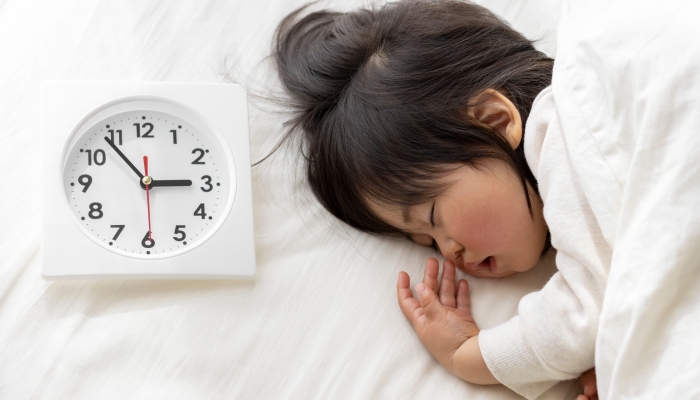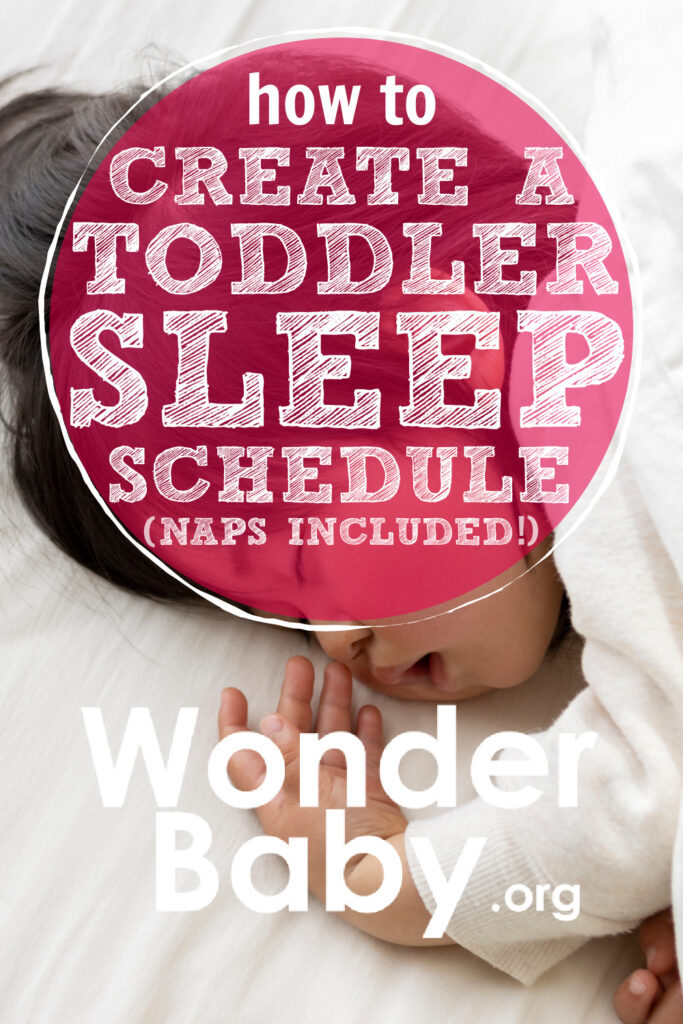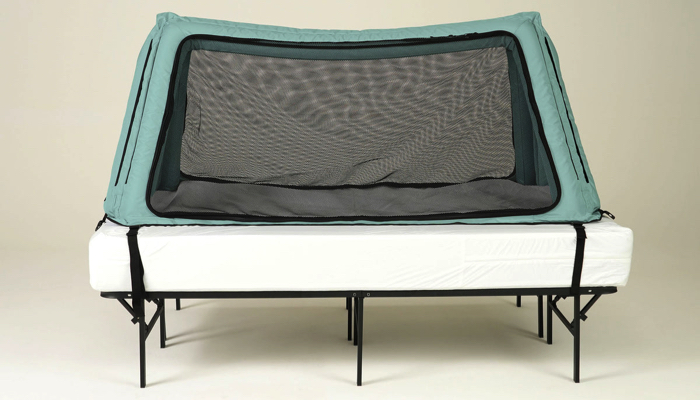How to Create a Toddler Sleep Schedule (Naps Included!)

- The toddler age group only includes children ages 1 to 3 years old.
- Toddler sleep is important for many reasons, including overall development.
- Any sleep schedule is customizable, but there are many factors to consider.
- A consistent bedtime routine, nap schedule, and quiet sleep environment are all helpful for helping your child fall asleep and stay asleep.
Sleep—quite possibly the only time you’ll witness your busy toddler completely still. Sometimes these moments of stillness are easier said than done, though, especially when your toddler lacks a sleep schedule. If the timing is off or if there’s no established schedule at all, you could be in for a world of trouble.
With my first child, I experienced this first hand. I didn’t know the ins and outs of sleep training a toddler. I figured my toddler’s body would tell her when she needed sleep, so I’d know when she needed it too. It turns out she could go non-stop and the lack of a nap turned into a pre-bedtime crash that would put any toddler tantrum to shame.
I quickly found that scheduling my toddler’s sleep was not just necessary but vital to surviving my day to day with two kids under two. Whether you’re like I was, trying to correct a misstep in toddler sleep, or you’re prepping for your almost toddler, a toddler sleep schedule is essential.
Toddler Sleep Schedule: What Parents Should Know
Before we jump in, let’s clarify what a toddler is. The term toddler gets thrown around a lot when it comes to small children. This age only includes children from 1 to 3 years old, though—something to keep in mind moving forward! That said, let’s break down some of the common questions before we get into the scheduling specifics.
For starters, how much sleep does this age group actually need? A child just entering the toddler stage at one year old through their second year will need somewhere between 11 and 14 hours of sleep per day. This is their total sleep including their naps as well (bummer, I know). Once they reach 3, the total timing shifts to around 10 to 13 hours of sleep per day.
Speaking of toddler naps, your little one will nap anywhere from 1 to 3 hours per day. For their first year of toddlerhood, they’ll likely split this time over two naps. Once they reach age 2, though, you’ll see them start to transition to one nap per day.
How much sleep they need varies from child to child though. That brings us to nighttime sleep.
As they reach toddler age, your child should be able to sleep through the night. I say should because many factors can affect a child’s sleep and lead to night waking. It’s common for kids this age to start experiencing nightmares, accidents from nighttime potty training, or simply need some comfort from time to time. It all tends to differ from child to child.

Do Toddlers Need a Sleep Schedule
It might be tempting to throw scheduling out the window and go with the flow. In the end though, nothing could be more maddening for all involved. Toddler sleep is important for a number of reasons including:
- Promotes motor skills development
- Reduces the risk of obesity
- Mitigates excess negative emotions
- Fosters attention span
- Aids in positive mental development
- Protects and nurtures a child’s physical growth
If that wasn’t enough, according to Jodi Mindell a Ph.D psychologist in the article titled Benefits of a bedtime routine in young children: Sleep, development, and beyond published in 2017, “Common, adaptive components of a bedtime routine can contribute to an array of positive developmental outcomes beyond improved sleep, inclusive of language development, literacy, child emotional and behavioral regulation, parent-child attachment, and family functioning, among other outcomes.”
Clearly without a routine, your child could be missing out on some much needed advantages of a good sleep schedule. A consistent toddler bedtime routine promotes more than just healthy sleep habits.
This is just a shortlist of reasons your child’s schedule should be a priority—there’s more where this came from! Toddler aside, one other consideration for your little one’s schedule comes down to one word: you.
Without proper naps or night sleep, you’ll end up with a cranky, frustrated, ball of emotions—and let’s face it, that doesn’t make for an easy day. Also, when your toddler sleeps, you get a much deserved break. It’s healthy to take a brain break and reset yourself for the remainder of the day ahead or the next day to come.

Creating a Sleep Schedule for Your Toddler
While no child’s schedule is exactly the same, there are tons of sample toddler sleep schedules to help gauge what might work best for them. Take a look at this sample schedule below for a 2 year old, noting what could be moved around to fit your family’s lifestyle.
| 6:30 am | Wake Time |
| 7:00 am | Start Breakfast |
| 9:30 am | Snack Time |
| 11:30 am | Lunch Time |
| 12:00 pm | Quiet Activity |
| 12:30 – 2:30 pm | Nap Time |
| 2:45 pm | Snack Time |
| 6:00 pm | Dinner Time |
| 6:30 pm | Bath and Bedtime Routine |
| 7:00 pm | Bedtime |
With nothing set in stone, you can shift this schedule around based on your toddler’s sleep and wake patterns. Even though there’s plenty of room for customization, there are a few factors you’ll want to remember when you’re creating a schedule for your child’s sleep.
- Be sure not to let your toddler sleep past the scheduled time during their naps. If your toddler is sleeping a lot during the day, you run the risk of delayed bedtimes or early waking in the mornings. Do yourself a favor and wake them when it’s time!
- Watching for overtiredness can help you pinpoint the optimal rest times for your toddler. You want to schedule their nap and bedtimes before they reach this point to avoid that rush of overtired, grouchy energy.
- Recognize when your toddler has outgrown their bedtime and nap schedule and begin to adapt. If you notice their sleep patterns changing, shift things around until the schedule works.
- Create a backup schedule for the days you can’t abide by the normal way of things. A shift in wake time, nap time, and the like can make those heavily scheduled days a bit easier when it comes to sleep.

Tips to Get Your Toddler to Sleep and Take a Nap on Time
We’ve talked a lot about the 1 to 3 year old sleep schedule, which is all well and good if you can actually get your toddler to sleep. If you’ve got the schedule but your toddler isn’t exactly on board, try these tips for more successful sleep:
- Probably the single most important tip to remember is that routine is key. Toddlers thrive on routine and this is especially true for sleep. Create a recognizable nap and bedtime routine for them that signals it’s time for rest.
- Quiet time prior to nap and bedtimes helps prep toddlers for the restfulness to come. An activity like reading a book together is perfect; offer interaction without a ton of stimulation that’ll wind them up.
- Creating a sleep space specific for your toddler is also a crucial step to getting your toddler to fall asleep and stay asleep. White noise, blackout curtains, and a cool temperature are all elements of a good toddler sleep environment that can make a huge difference.
- If your toddler is resistant to the idea of an afternoon nap or bedtime, put the ball in their court by giving them options. Ask them if they’d like to sing some nursery songs or read a book to get ready for nap or bedtime; or maybe they get to pick which cup or pajamas they want. This is a great way to stop those nap and bedtime battles.
FAQ
When do toddlers stop napping?
For the most part, toddlers will continue taking a nap through their second year. The good news is just under a quarter of 2 year olds try dropping their naps. Once they reach year three though, you may notice their need to nap reducing. Nearly half of 3 year olds will no longer nap.
While there may be the occasional nap, it can be hard when they stop cold turkey. Whenever your toddler decides to drop the naps, you can still incorporate quiet time. Laying them down in their bed with some books and safe toys allows for them to still get some rest, the same is true for you!
Is it normal for a toddler to snore or grind their teeth in their sleep?
Snoring is generally normal in most toddlers. Issues with allergies and tonsils are some common reasons. Even so, if the snoring continues long term or gets louder, it might be something to look into. More serious issues like apneas or sleep disordered breathing could be the underlying cause and need further attention.
Bruxism, also known as teeth grinding, isn’t entirely uncommon for many toddlers. They may do it to cope with other sources of pain or if their bite is off. Younger children may also do this when they’re teething as they’re not used to their new set of pearly whites. Usually in time, teeth grinding stops on its own, so no need to worry!
What are sleep regressions?
You may have heard the term sleep regression used in mom circles—likely not used in the fondest of ways either. Sleep regressions are interruptions in sleep for a child that usually sleeps through the night. Though they can be incredibly frustrating, these night wakings are a normal part of your toddler’s development.
They often happen around the 12, 15, and 18 month old marks. After that, sleep interruptions can still occur, but there’s a split opinion on if there’s truly a 2 year regression or if that’s due to other factors like nightmares. Regardless, all of these interruptions subside in time for a normal, consistent sleep pattern.

Related Posts

Sleep, Special Needs
Safe Place Bedding Travel Bed Review
Traveling with a special needs child can be stressful! Having a safe, durable, and easy to use travel bed can make traveling so much easier!

Sleep, Special Needs
Sleep Regimen for Premature Babies: Special Considerations
It can take premature babies much longer than their full-term peers to sleep for long stretches. A preemie sleep schedule may encourage better sleep.

Sleep
Mastering the Bedtime Routine: 3 Tips for a Peaceful Night’s Sleep
From around six weeks, a newborn bedtime routine can help your baby learn the difference between day and night and prepare for a restful night’s sleep.